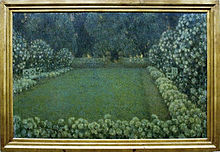
A monochromatic garden is a garden in which a single color is highlighted.
Single-color gardens
Such a garden is planted so that it overwhelms the observer with a single color. While this may seem a rather bland approach at first, such gardens were made popular by the work of famous garden designers such as Gertrude Jekyll and Vita Sackville-West. Sackville-West, for example, created what may have been one of the most famous single-color gardens, the White Garden room of the Sissinghurst Castle Garden.

Many single-color gardens use flowers of different shades, such as light yellow and deep gold, or a range that includes dark burgundy, bright scarlet, and also pink for a red garden. (A similar idea uses analogous colors, such as purple, red, and orange, rather than a single color.) Plants with colored leaves, such as silver leaves or plants with variegated foliage for a white garden, might also be included.

The color for a monochromatic garden may be chosen for any reason, including to fit a small garden, as part of a clean, contemporary design, or to highlight a favorite color. Another possibility is an all-green garden, which may feel peaceful or harmonious. A monochromatic edible garden is possible, but more challenging to design than a flower garden in any color except green. Yellow variegated leaves can be difficult to include in a multi-colored garden, but they blend easily into an all-yellow garden, such as all-yellow Gold Border garden at Wave Hill in New York.
Beyond the choice of color, single-color gardens are designed with a variety of types and sizes of flowers as well as plants of different heights, shapes and textures. Other elements of the garden, such as pathways, walls, and furniture, may match or contrast with the chosen color.
White garden

A white garden is a feature garden composed of plants that produce white flowers and spathes as well as plants with a white or silvery cast to their foliage. The white garden is a variant of the color garden. The most essential feature of the white garden is its unity of color.

The white garden is an informal gardening style that is similar in design to the English cottage garden. The open and informal design creates associations with romance, peace, and elegance. The white flowers are not usually placed in clusters, but spread throughout the garden's green areas, creating a natural look and feel. The mildly dense placement of white flowers creates a luminescent sight that is especially powerful in the twilight. Because of this effect, they are sometimes called moon gardens.
The white flowers in a white garden are not necessarily pure white; they may have hints of other colors, such as gray, blue, pink, yellow, or green. The White Garden at Sissinghurst, for example, contains white, grey and silver.
Flowers used in white gardens may include:
- White camellia
- Shasta daisy
- White lilac
- Madonna lily
- White periwinkle
- White rose
Role of symbolism
The color white, and white flowers in particular, carry a vast amount of symbolism.
In parts of the US in 1915, single-color flower gardens featuring yellow flowers were used as a symbol of support for women's right to vote.
See also
References
- ^ Phillips, Charles (2004). Color for Life. Ryland Peters & Small. pp. 29, 77. ISBN 978-1-84172-691-5.
- ^ Taylor, Patricia A. (1995). Perennials. Better Homes and Gardens Books. p. 24. ISBN 978-0-696-02554-9.
Probably the most famous single-color garden is Vita Sackville-West's white garden at Sissinghurst in England.
- ^ Halpin, Anne Moyer (2006-01-01). "Planning and Designing". Seascape Gardening: From New England to the Carolinas. Storey Publishing. p. 38. ISBN 978-1-58017-531-9.
- ^ Better Homes & Gardens (2010-12-28). Better Homes & Gardens Perennial Gardening. John Wiley & Sons. pp. 58–59. ISBN 978-0-470-87844-6.
- Hill, Lewis; Hill, Nancy (2012-05-04). The Flower Gardener's Bible: A Complete Guide to Colorful Blooms All Season Long: 400 Favorite Flowers, Time-Tested Techniques, Creative Garden Designs, and a Lifetime of Gardening Wisdom. Storey Publishing, LLC. p. 35. ISBN 978-1-60342-807-1.
- Morrison, Susan (2018-02-07). The Less Is More Garden: Big Ideas for Designing Your Small Yard. Timber Press. p. 151. ISBN 978-1-60469-791-9.
- Soler, Ivette (2011-02-23). The Edible Front Yard: The Mow-Less, Grow-More Plan for a Beautiful, Bountiful Garden. Timber Press. p. 108. ISBN 978-1-60469-199-3.
- Christopher, Thomas (2019-09-17). Nature into Art: The Gardens of Wave Hill. Timber Press. pp. 58–69. ISBN 978-1-60469-851-0.
- Heath, Carolyn (1994). 550 Perennial Garden Ideas. Simon and Schuster. p. 92. ISBN 978-0-671-79839-0.
- Helen Champion. "A moonlit masterpiece at Sissinghurst Castle Garden". National Trust. Archived from the original on 3 October 2018. Retrieved 3 October 2018.
- Chapman, Mary (2014-03-20). Making Noise, Making News: Suffrage Print Culture and U.S. Modernism. Oxford University Press. pp. 143–144. ISBN 978-0-19-998830-3.
| Color topics | ||||||||||
|---|---|---|---|---|---|---|---|---|---|---|
| Color science |
|  | ||||||||
| Color philosophy |
| |||||||||
| Color terms |
| |||||||||
| Color organizations | ||||||||||
| Names |
| |||||||||
| Related | ||||||||||
This garden-related article is a stub. You can help Misplaced Pages by expanding it. |